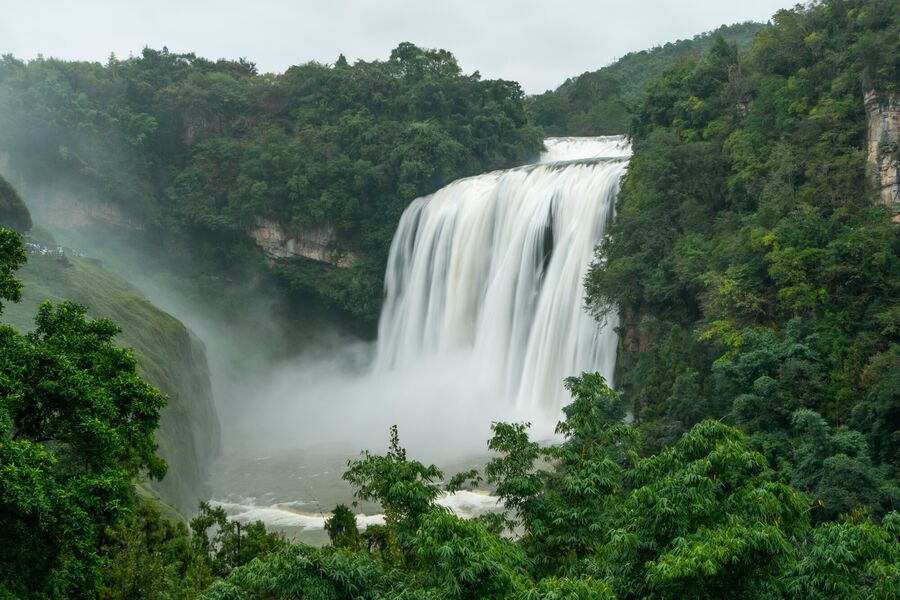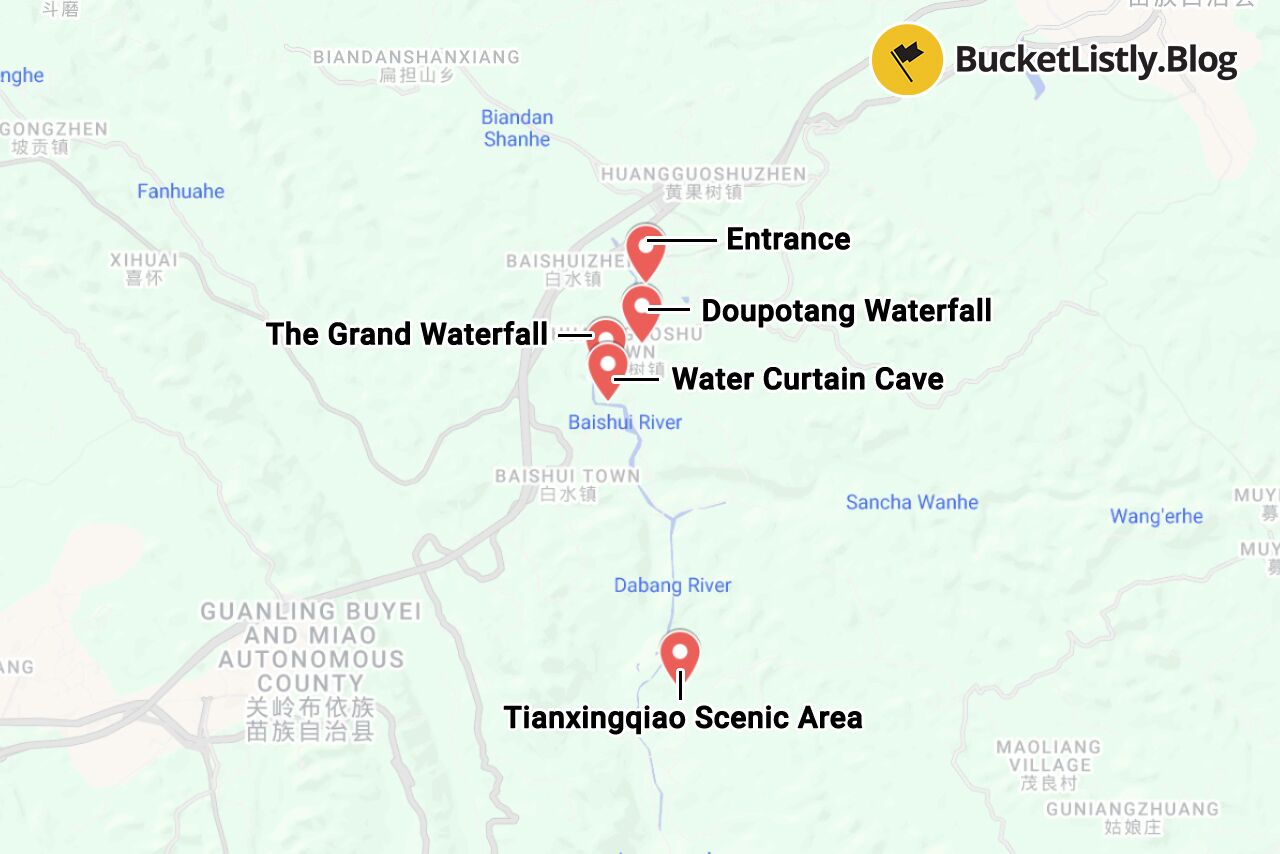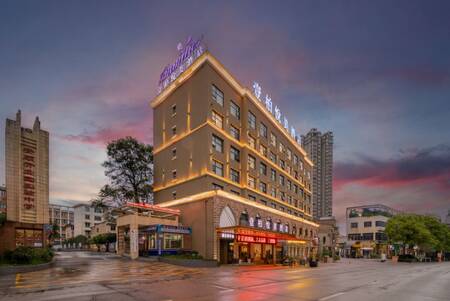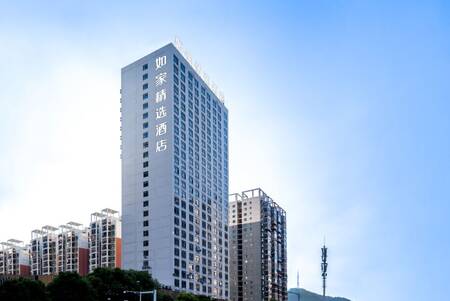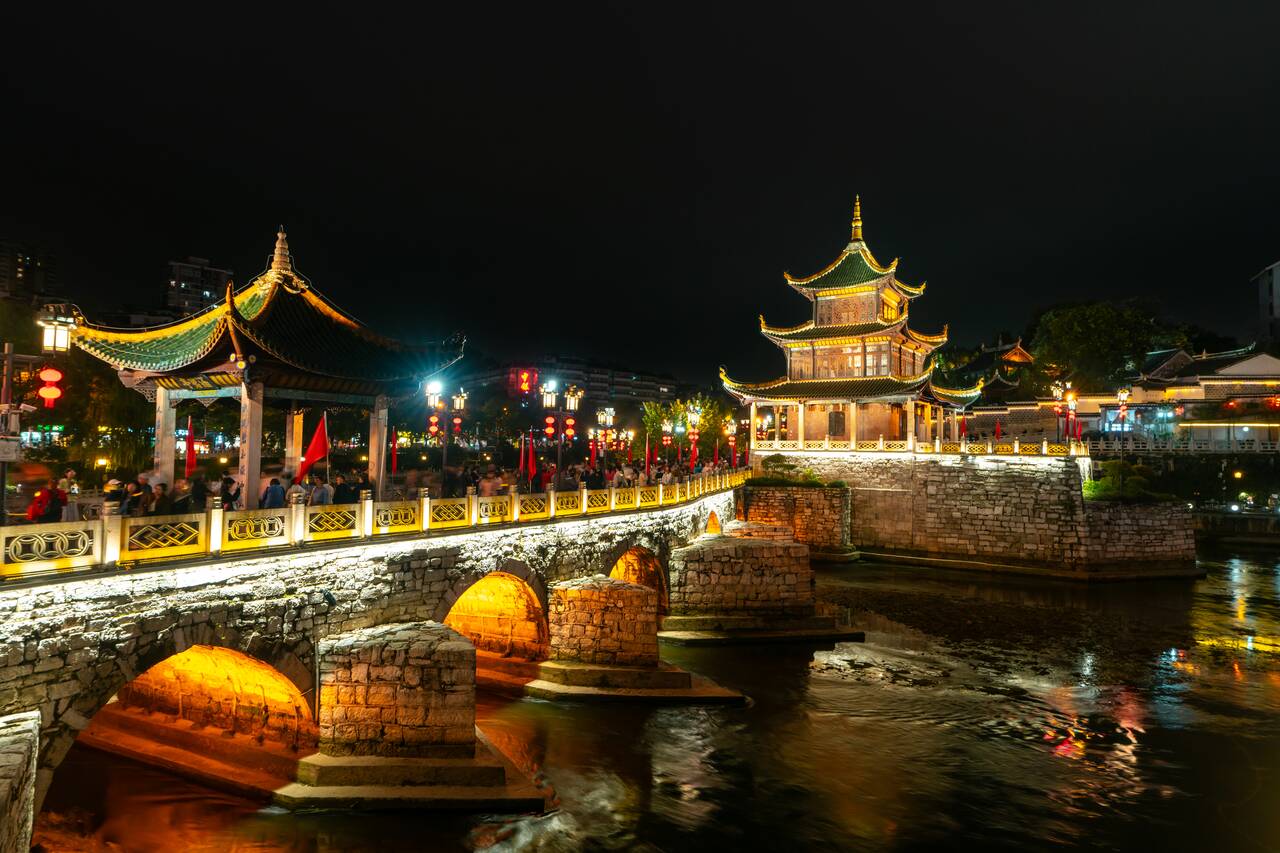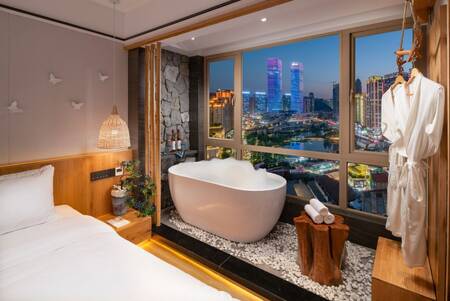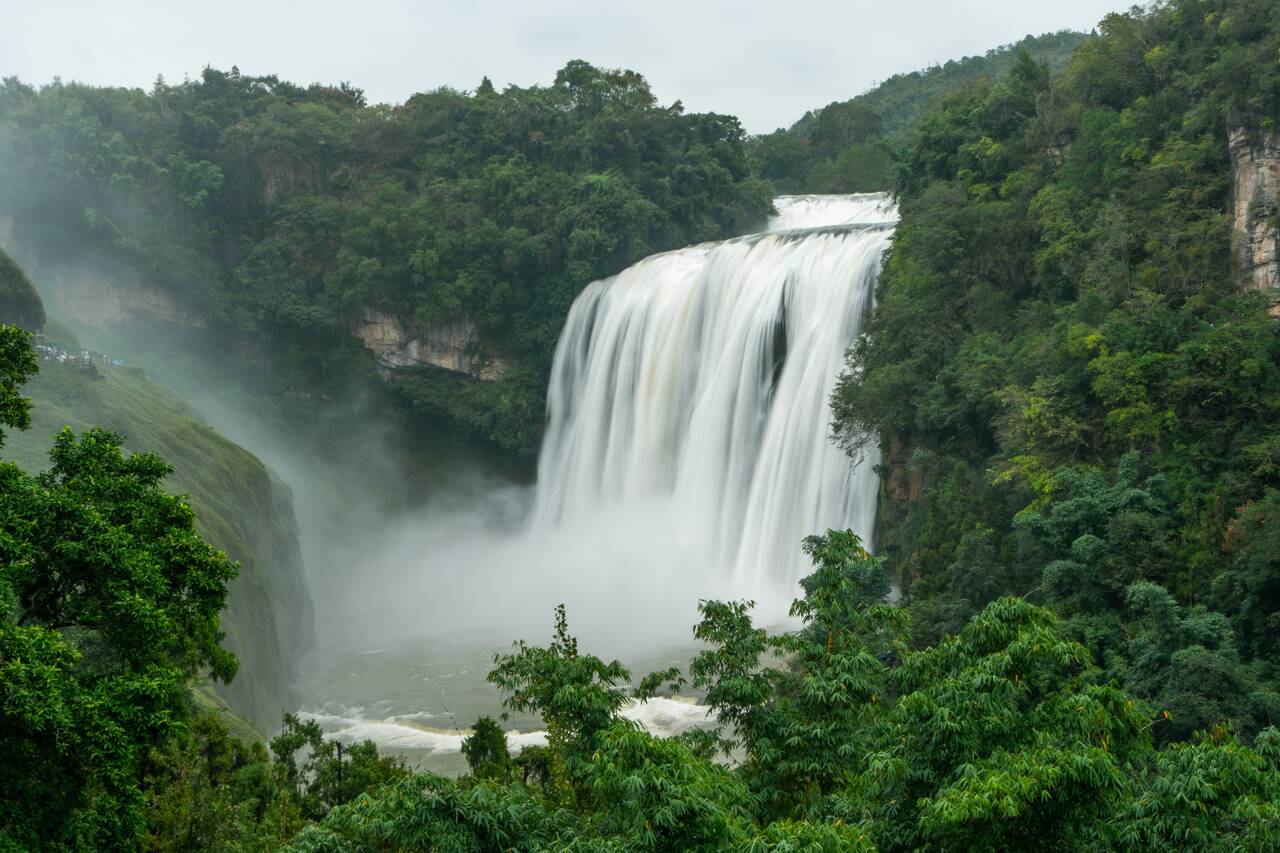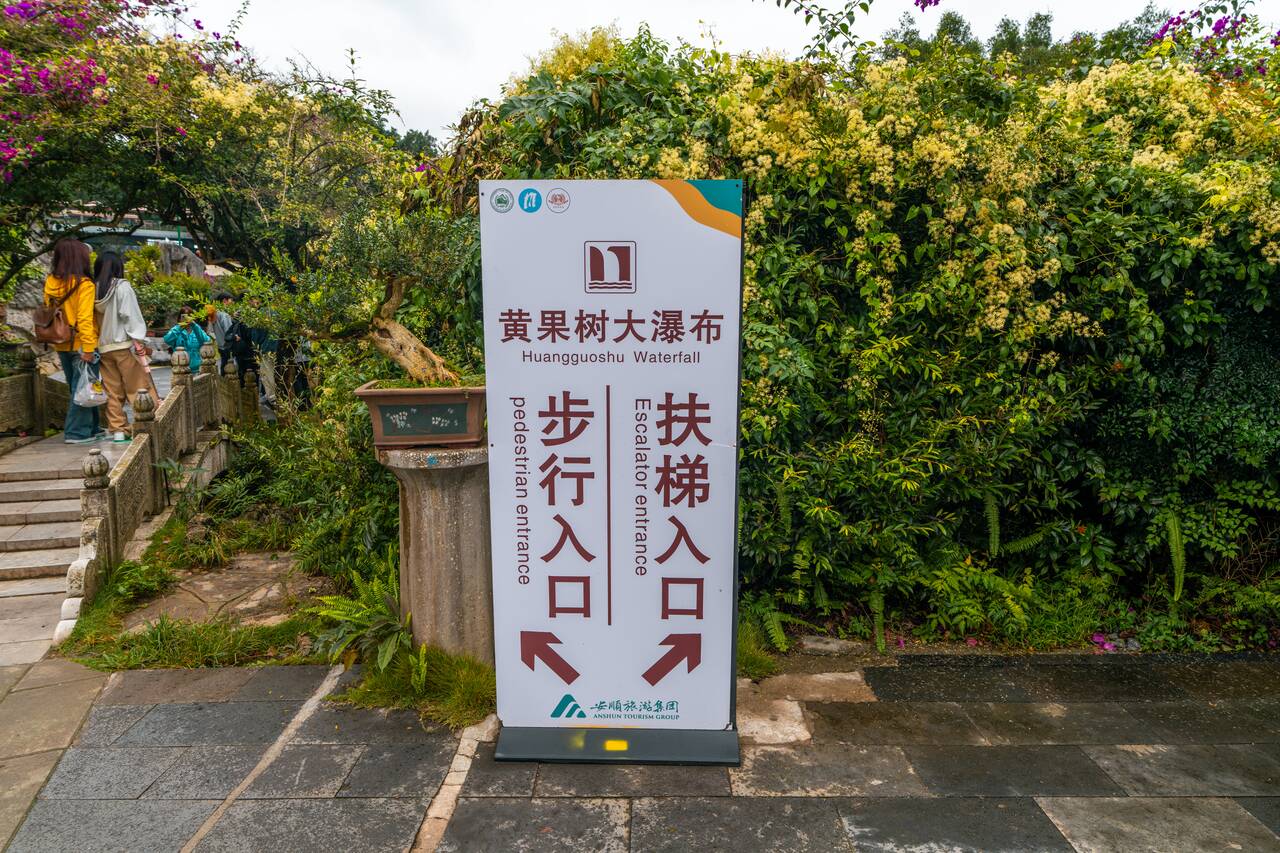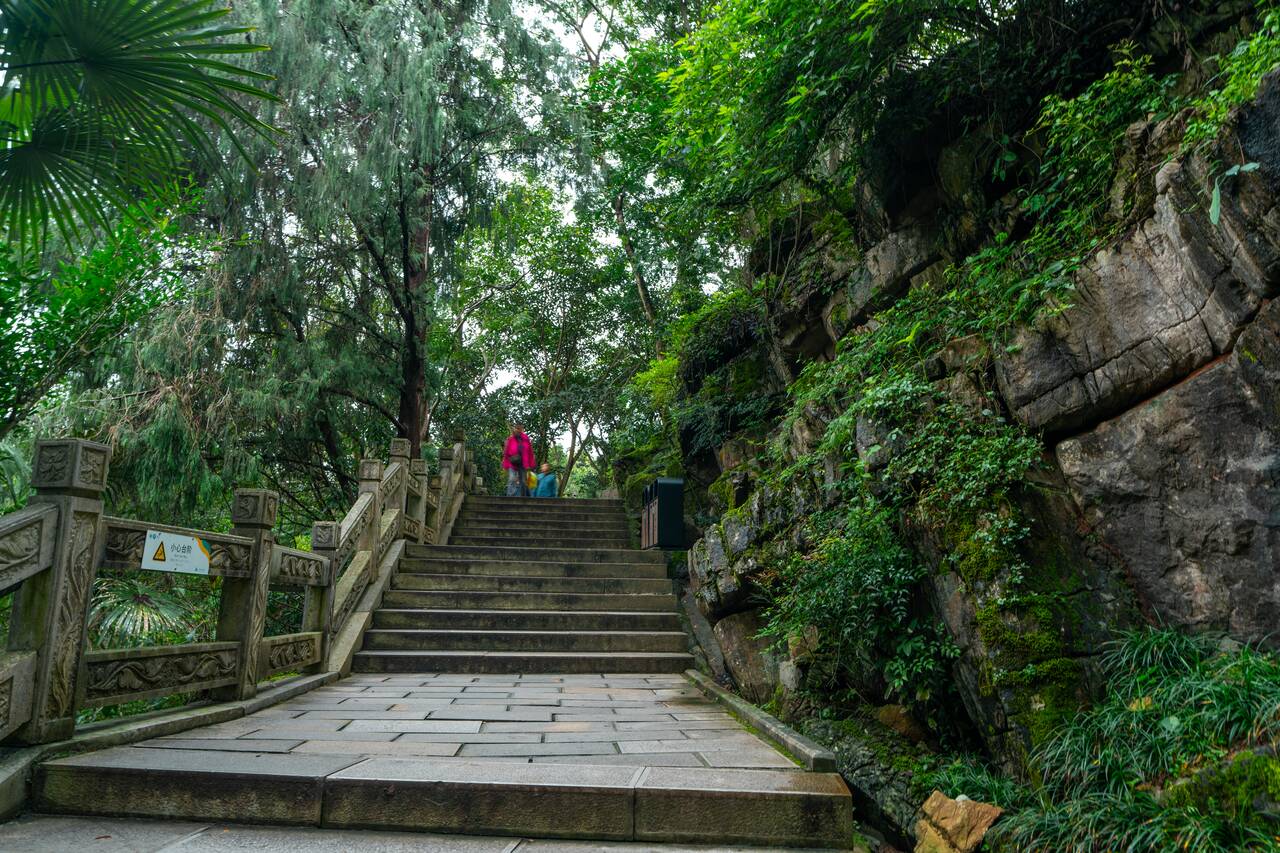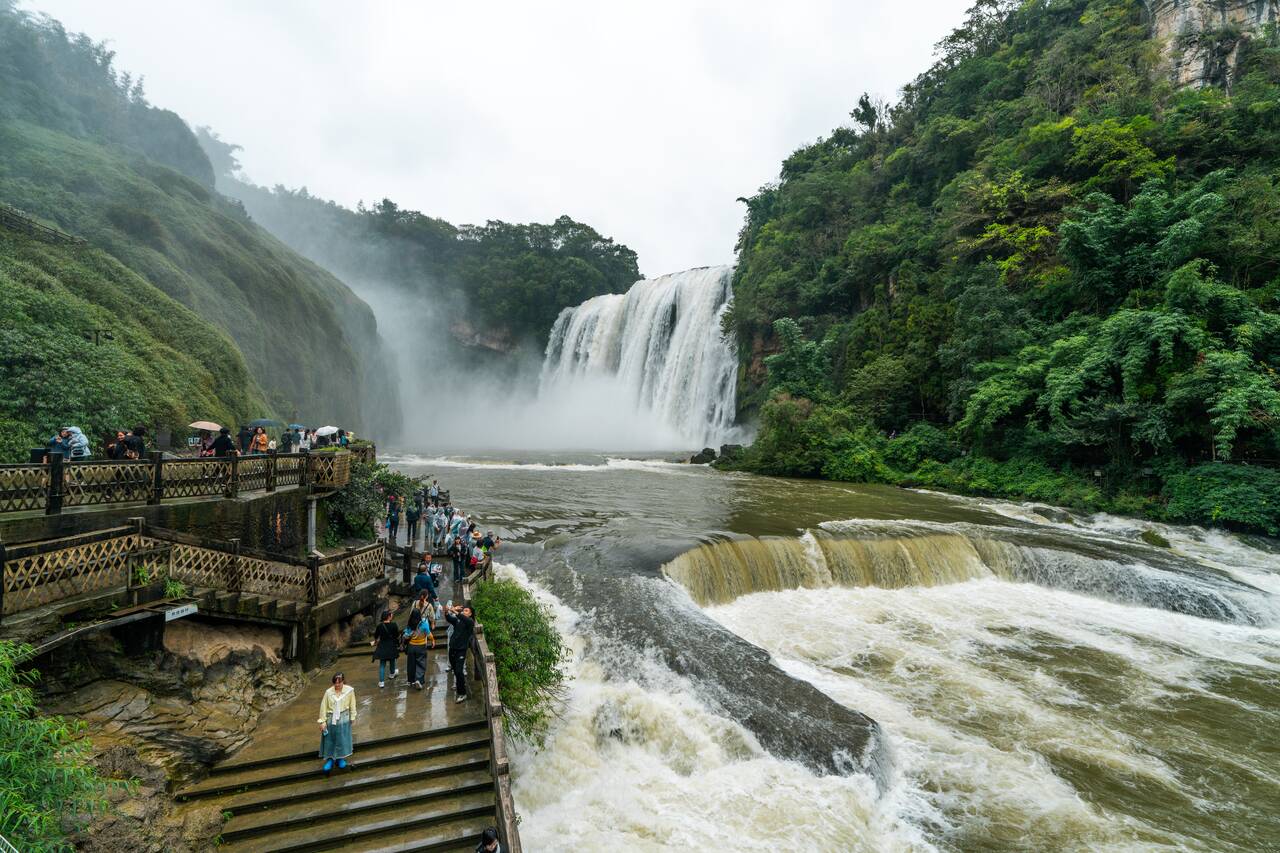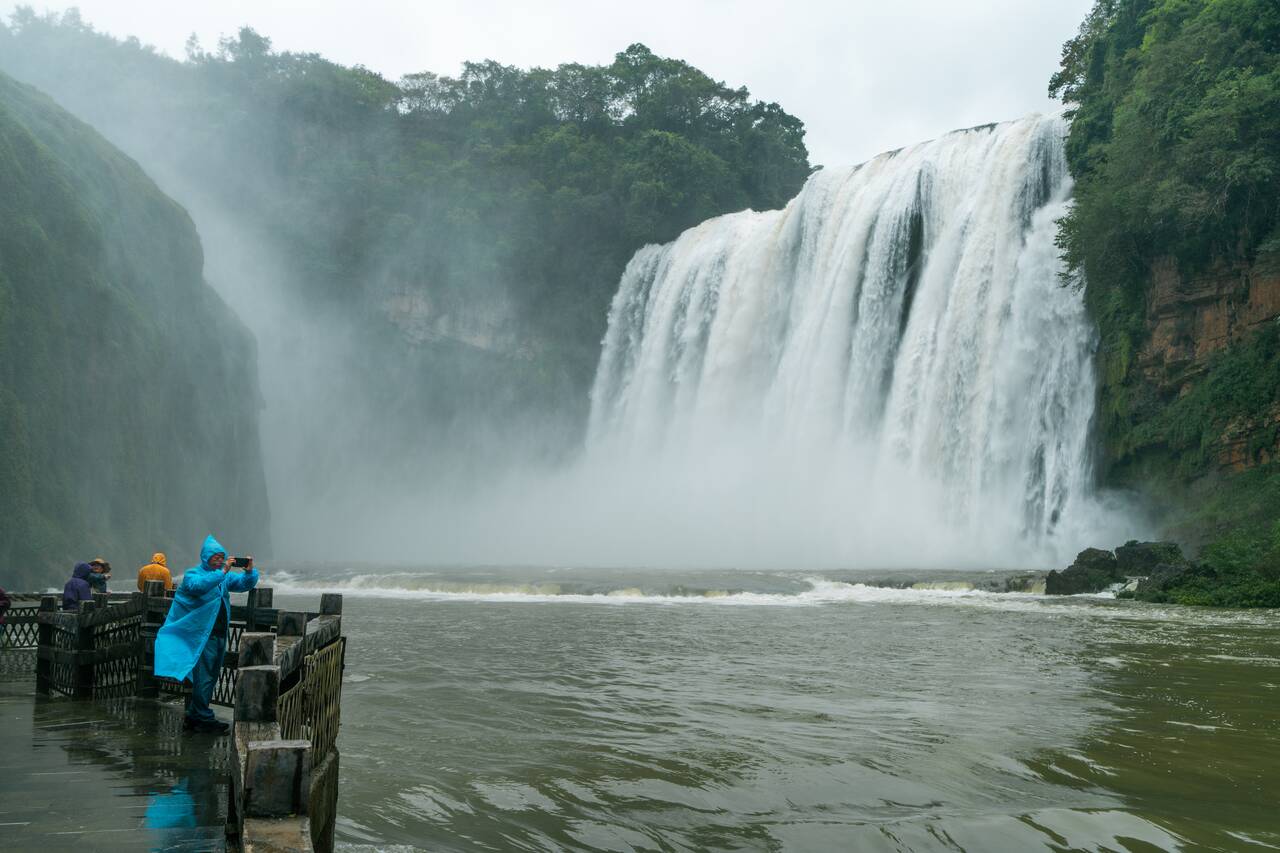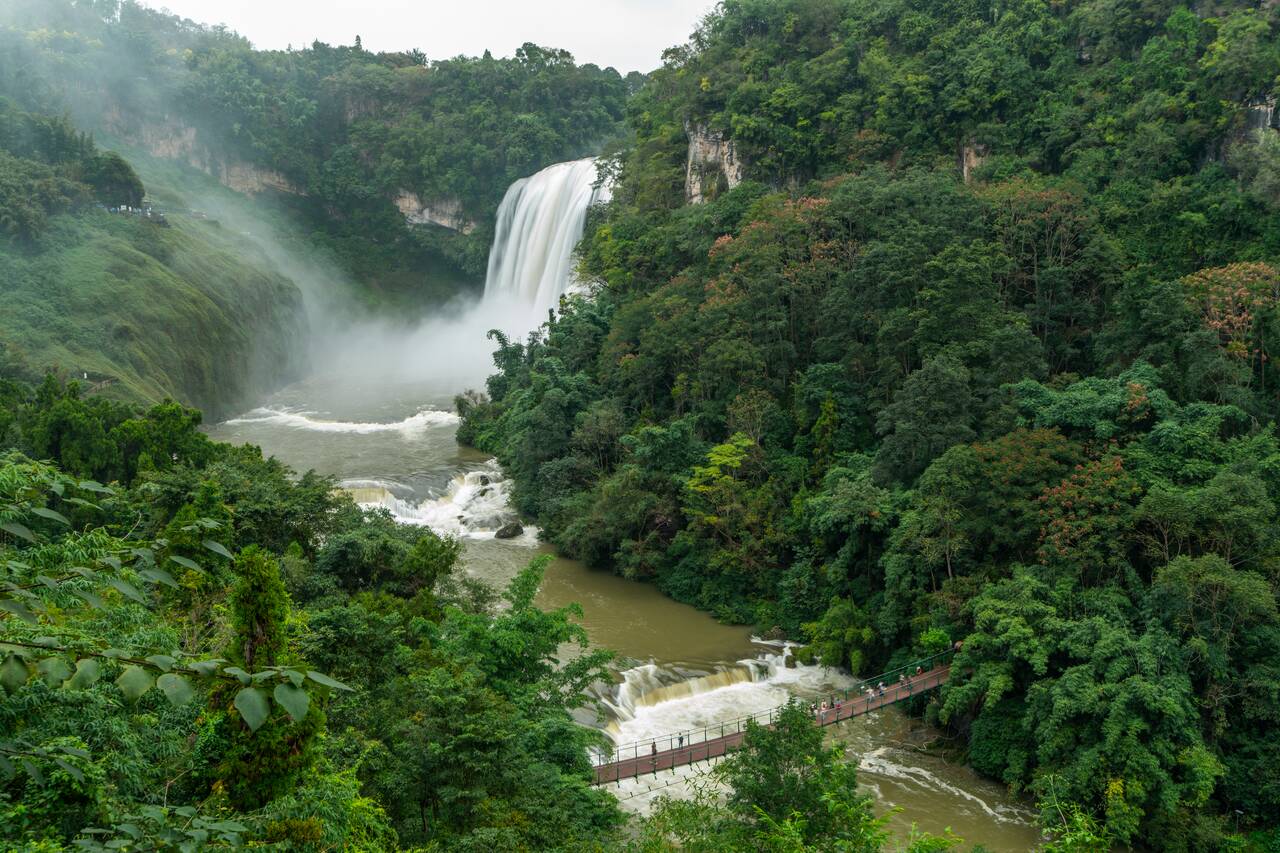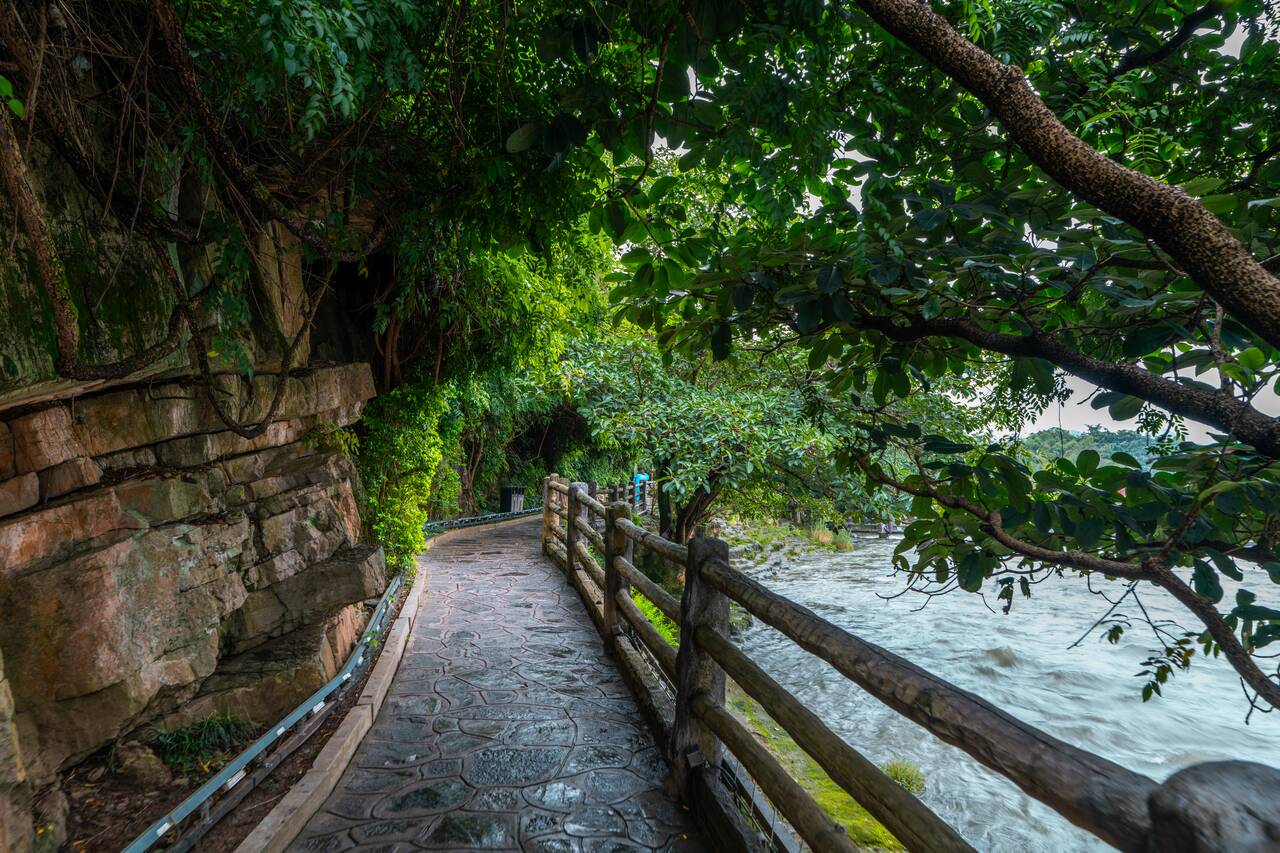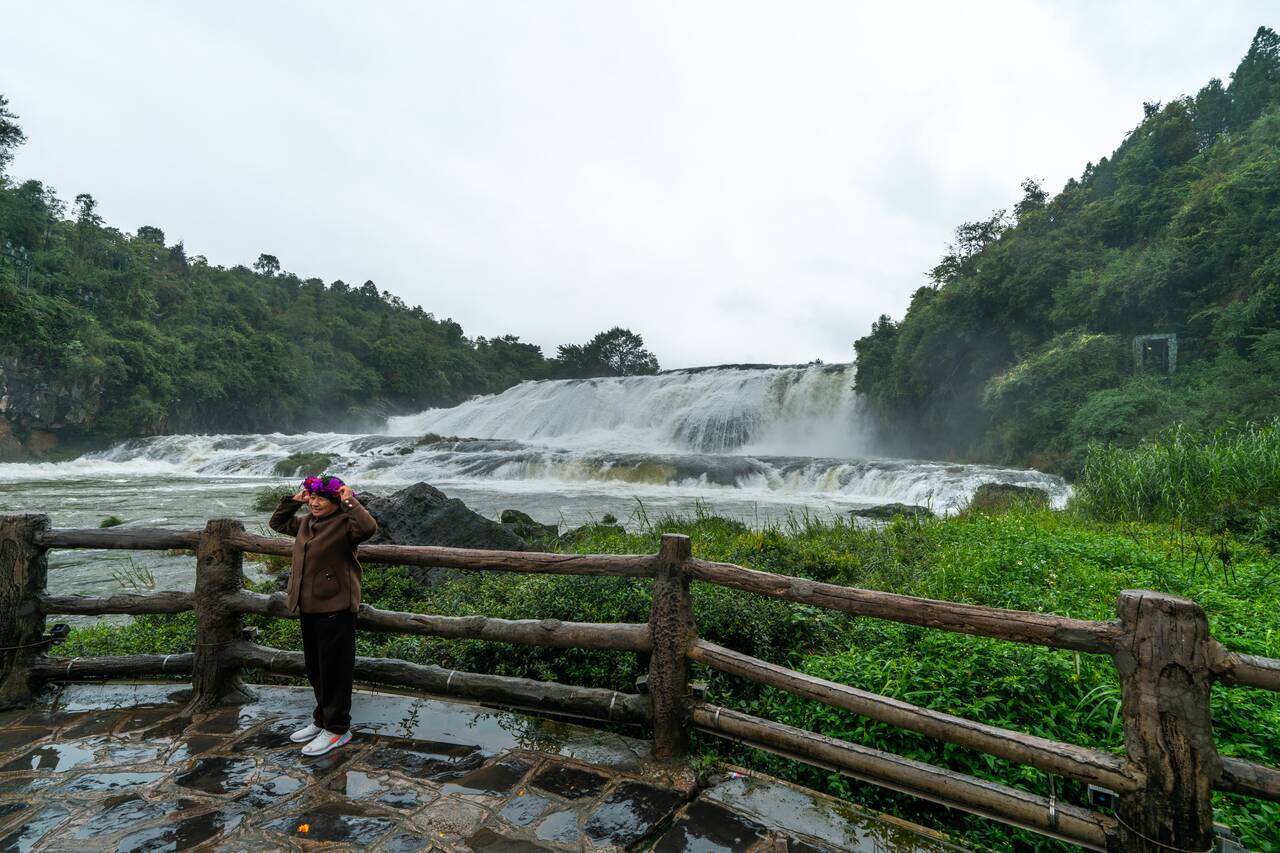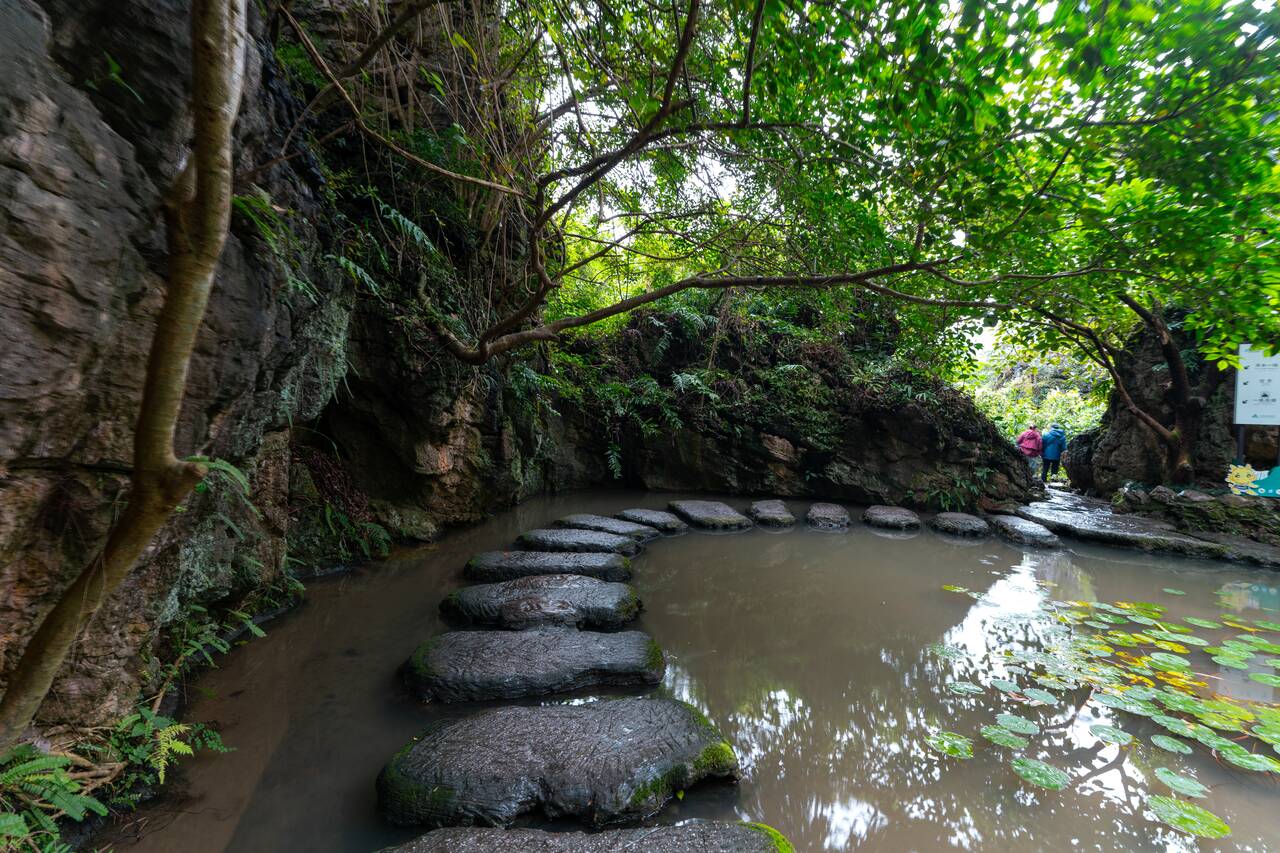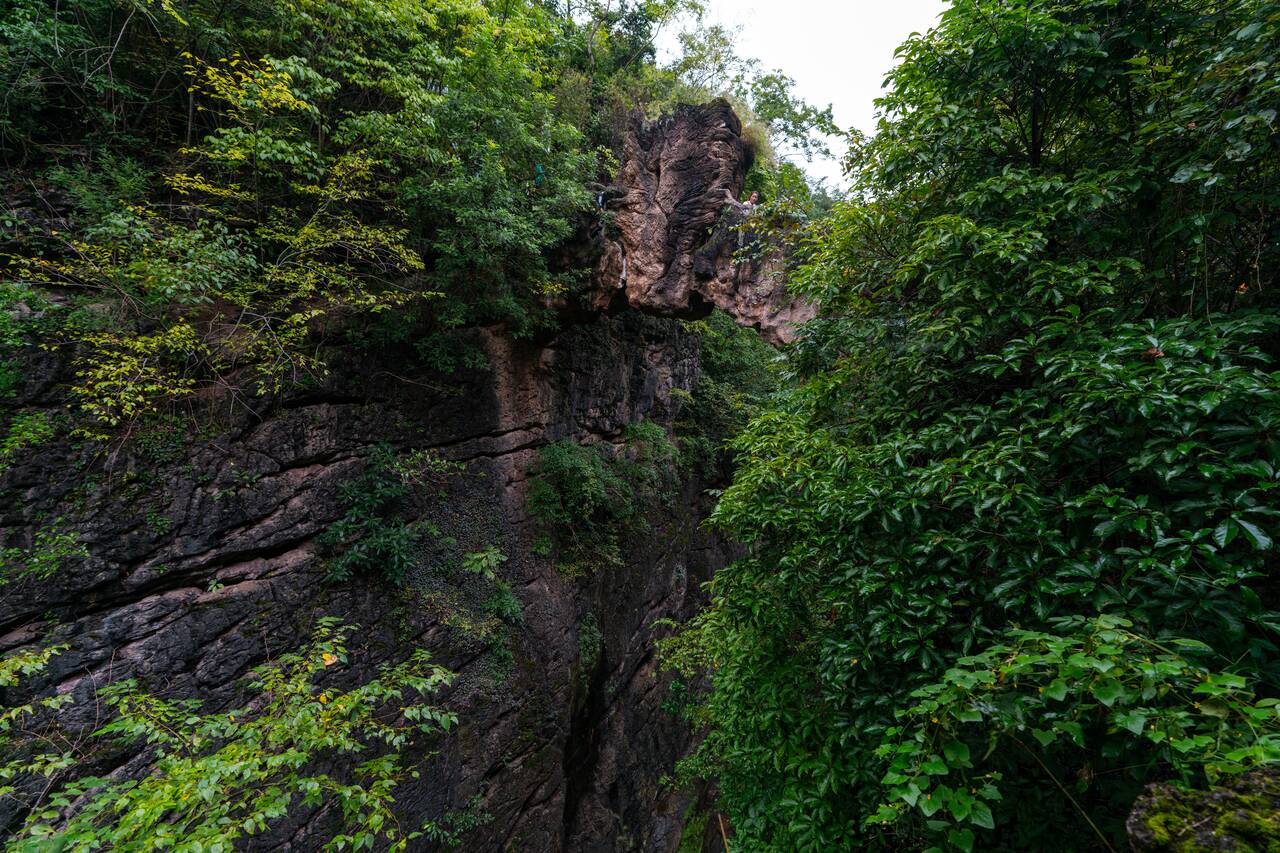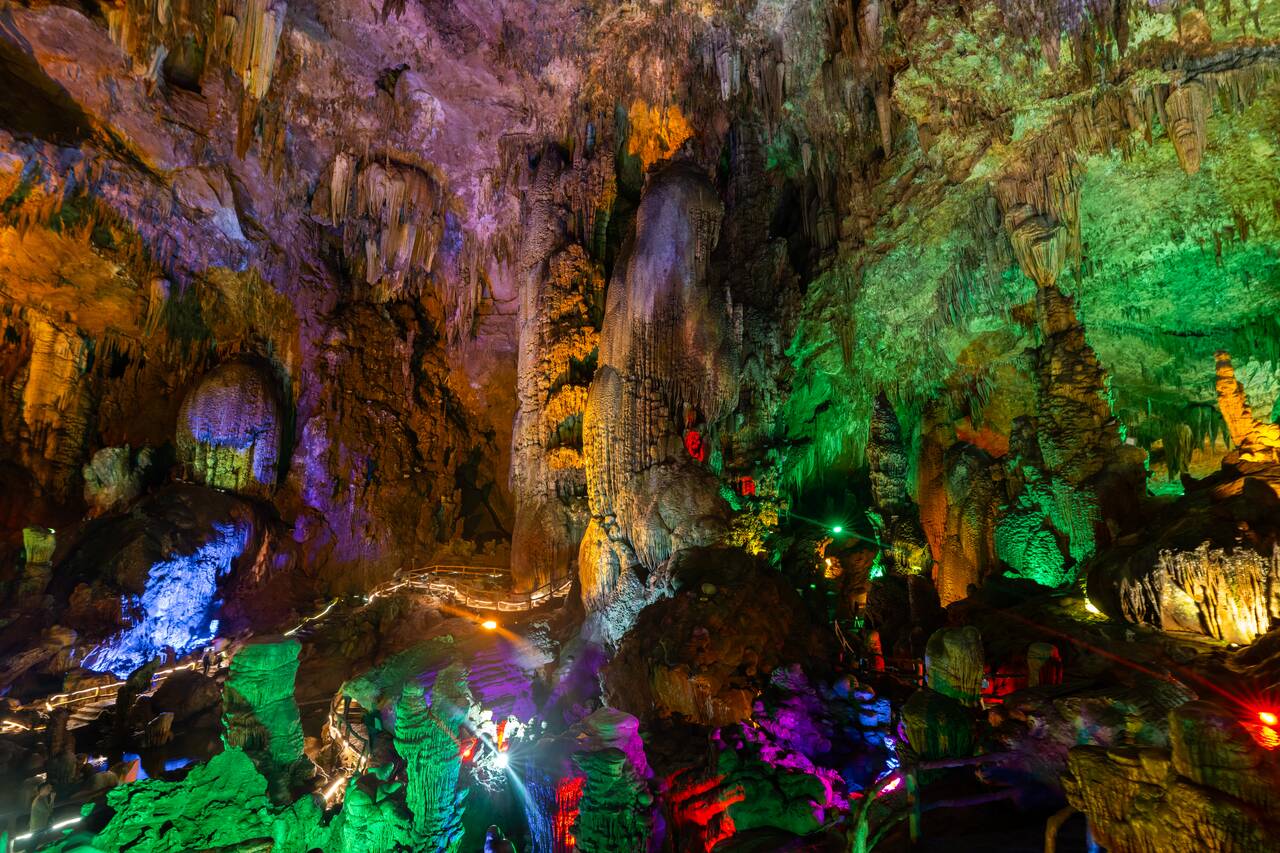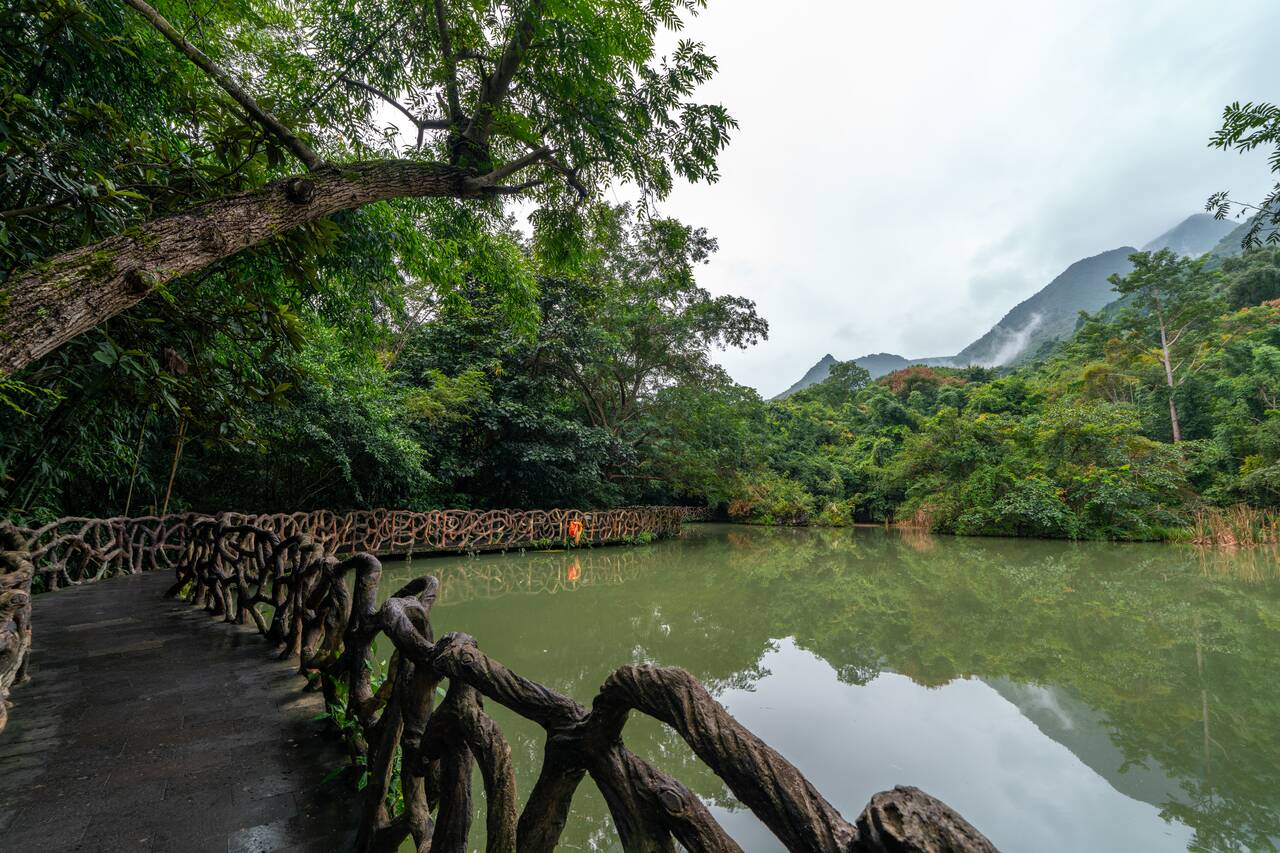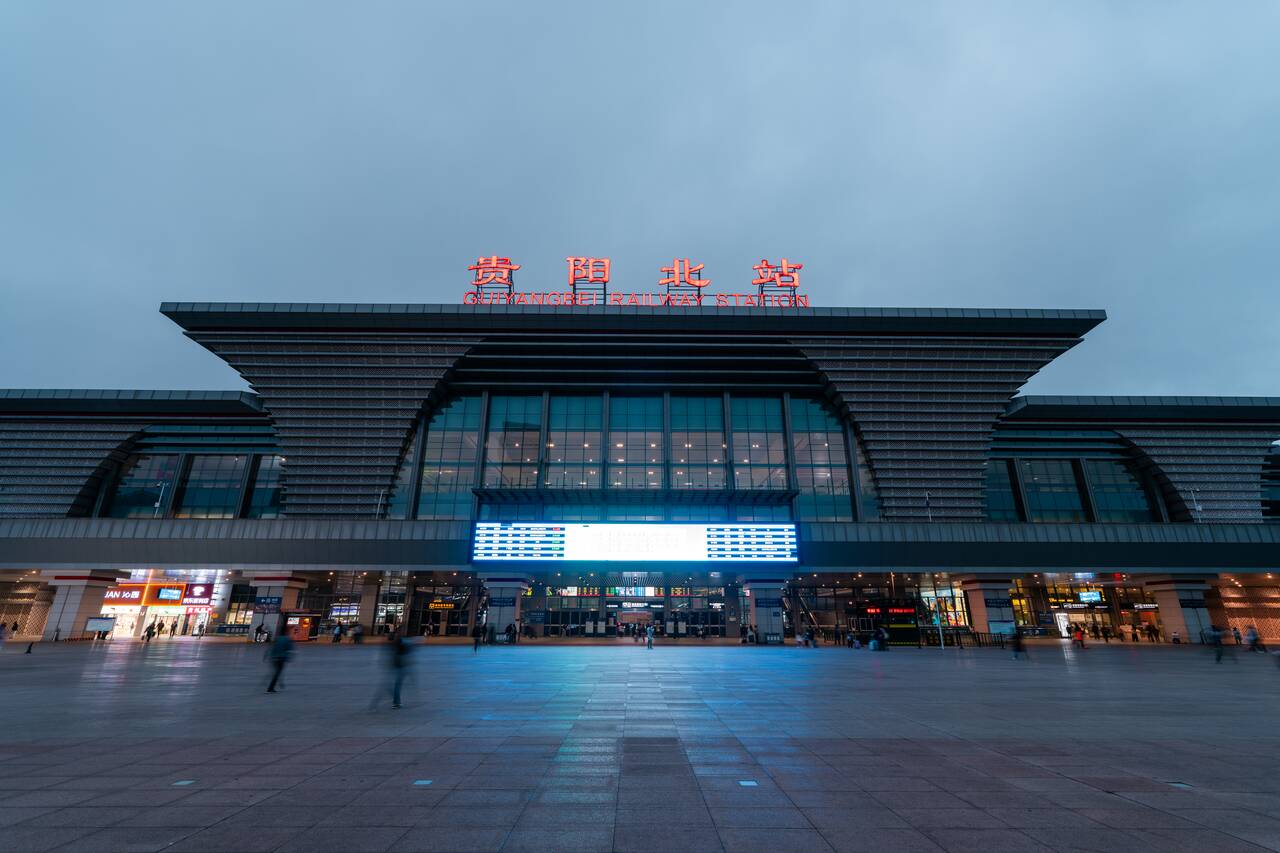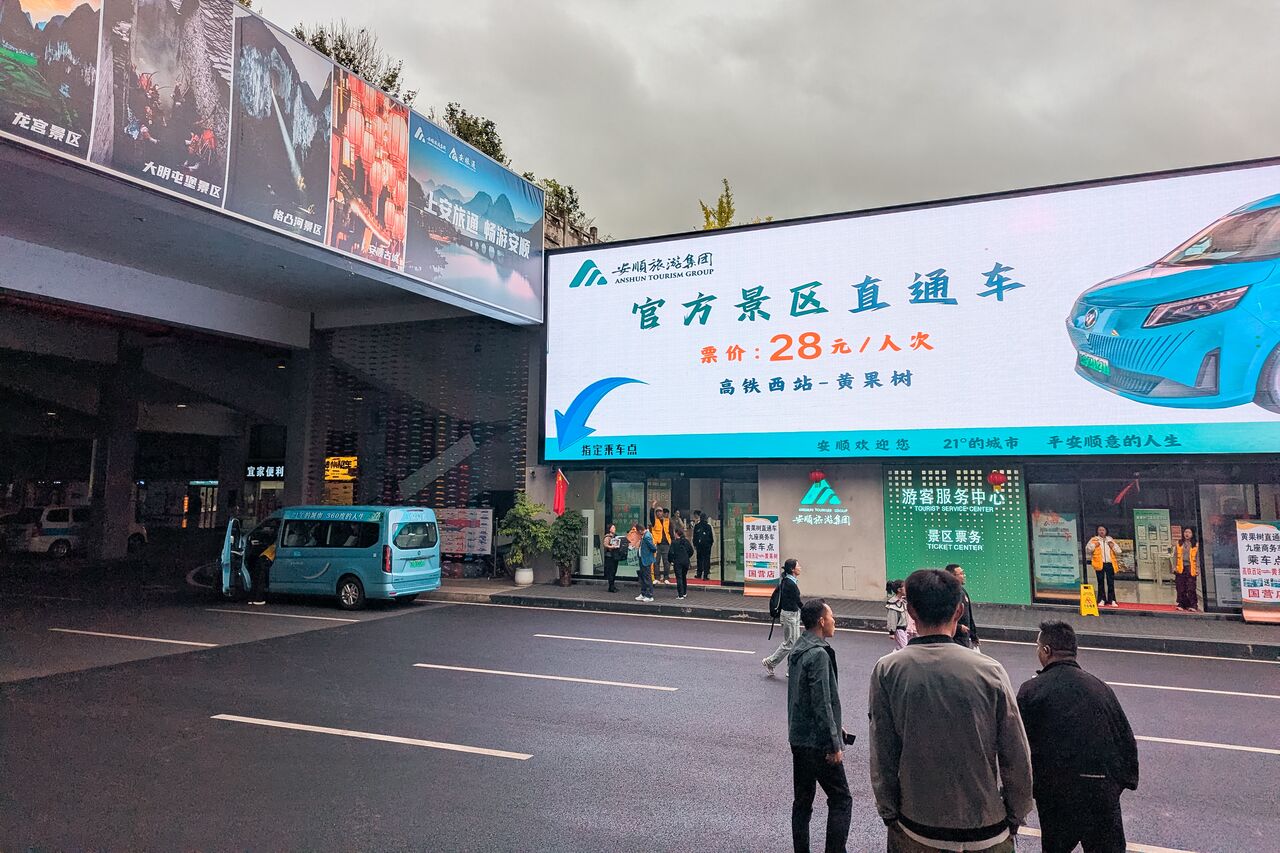As the largest waterfall in Asia, spanning 77.8 meters in height and 101 meters in width, Huangguoshu Waterfall is a must-visit for anyone exploring Southern China. It offers a perfect opportunity to discover Guizhou, one of the most underrated provinces in the country, and to step off the usual tourist path. You will barely see any foreign tourists here.
Huangguoshu Scenic Area covers over 120 square kilometers, including not only the main waterfall but also several smaller waterfalls, caves, rivers, and lush karst landscapes. Planning a visit can be extremely overwhelming, which is why I’ve put together this complete travel guide. From how to get here and where to stay to the places you shouldn’t miss, here’s everything you need to know to make the most of your trip to Huangguoshu Waterfall!
- Huangguoshu Waterfall Points of Interest Map
- Where to Stay near Huangguoshu Waterfall?
- Places to Visit at Huangguoshu Waterfall
- Things to Know Before Visiting China
- When to Visit Huangguoshu Waterfall?
- How to Get to Huangguoshu Waterfall?
- How to Get Around Huangguoshu Waterfall?
- What are Huangguoshu Waterfall Opening Hours and Entrance Fee?
- What to Pack for Huangguoshu Waterfall?
- Further Reading for China, Hong Kong, and Macau
Huangguoshu Waterfall Points of Interest Map
Where to Stay near Huangguoshu Waterfall?
Staying in Anshun: The nearest city to Huangguoshu Waterfall is Anshun, and if you are planning to visit only the waterfall and nothing else, like Kaili and its stunning stockaded Miao Villages, then Anshun is a great place to stay overnight. Here are some recommended accommodations in Anshun:
Staying in Guiyang: Since I was visiting Huangguoshu as part of a larger Guizhou trip, I decided to stay in Guiyang instead of Anshun and visit the waterfall as a day trip. Guiyang City isn’t the prettiest place, and it can feel a bit gritty at times, especially around Guiyang North Railway Station with all the ongoing construction, but it’s a convenient base for quick and easy day trips in the area.
If you plan to explore more places in Guizhou Province, you may want to consider staying in Guiyang instead of Anshun. Here are some recommended accommodations in Guiyang:
Places to Visit at Huangguoshu Waterfall
The Grand Waterfall
First and foremost, I recommend starting your visit at the Grand Waterfall Scenic Area, home to the crown jewel of the park, the magnificent Huangguoshu Waterfall. After purchasing your ticket and entering the scenic area, take the shuttle bus from the "Entrance to the Grand Waterfall Scenic Area Carriage Way" bus stop, which is located on the right-hand side.
This is also where you can choose to take the escalator down and go through the Water Curtain Cave, which runs behind the waterfall. If you want to do this, be sure to purchase the correct ticket before entering the scenic area. Once you arrive, follow the fenced pathway to the right to access the escalator down.
For those who prefer to hike, you can take the regular walking trail, which leads all the way down to the viewing platforms by the river. The hike takes about 15–20 minutes one way. Keep in mind that you will need to climb back up to catch the shuttle to the next area, which is much more strenuous, so make sure to bring plenty of water.
Once you arrive at the viewing platform, you will be treated to a truly impressive view of Huangguoshu Waterfall and its enormous scale. From here, it’s easy to see why it’s considered the largest waterfall in Asia. The sheer volume of water cascading down is absolutely spectacular.
The closer you get, the wetter you will become, thanks to the mist created by the waterfall’s massive 77-meter drop. Be sure to bring a rain jacket if you want to get up close and personal. You will also get a bit wet when entering the Water Curtain Cave, so come prepared for that as well.
There are many viewing platforms at different levels to explore, so be sure to spend some time here. This is, without a doubt, the most spectacular view in the scenic area, so don’t forget to take plenty of photos. Expect to spend around an hour here before making your way back up to the shuttle bus stop and continuing to the next area.
Doupotang Waterfall
After you are done with the Grand Waterfall Area, you can take a shuttle bus to Doupotang Waterfall, which is located downstream towards the entrance of the park. This is a smaller, but equally charming waterfall within the Huangguoshu Scenic Area and you can walk on its elevated path that runs along the river all the way to the waterfall.
To be honest, out of all the 3 main areas in Huangguoshu Scenic Area, I found this place to be the least overwhelming not because the waterfall is not beautiful, but the elevated walkway doesn't get close enough to the waterfall to see just how impressive it is up close.
So why do I recommend visiting this area next? It’s because Doupotang Waterfall doesn’t attract as many tourists, allowing you to enjoy the peaceful surroundings as you stroll along the path that winds around the river. While there is still some walking involved, it’s less strenuous than the hike at the Grand Waterfall and doesn’t take as long as exploring Tianxingqiao Scenic Area, making it a perfect spot to relax and enjoy the scenery in relative solitude.
Here, you will also find many references to the famous novel and film Journey to the West, which was partly filmed in this area. After crossing the river, you’ll come across several statues of the film’s characters, along with a map showing their journey overlaid on a modern map, so you can see just how far west they traveled. It’s actually pretty cool!
Tianxingqiao Scenic Area
After visiting Doupotang Waterfall, take the shuttle bus to Tianxingqiao Scenic Area, my personal favorite. Unlike the Grand Waterfall, which is all about sheer scale, Tianxingqiao is known for its dramatic karst formations, natural bridges, and clear rivers. The area offers a variety of landscapes and walking trails, which I absolutely love exploring.
You can explore the area via well-marked paths and boardwalks, crossing rivers and streams along the way. The whole area feels like a massive Chinese Zen Garden with wonderful rock formations and my favorite part: its stone pathways where you have to hop around the stones to cross ponds and rivers.
There is a lot to see in this scenic area, and it requires a bit more walking than Doupotang Waterfall. However, the effort is well worth it, as you’ll be rewarded with some of the most picturesque landscapes in the entire park. Along the trails, you’ll encounter many amazing attractions, including natural stone bridges that are absolutely mind-boggling to see.
Tucked away among these karst mountains, you will also find a remarkable cave system with a cavern so large that it completely blew me away. From the outside, the cave looks small, but the further you go in, the larger it becomes. It’s truly awesome.
Toward the end of the trail, you will come across Yinlian Zhuitan Waterfall. While it’s not very large, the volume of water and the proximity you can get, since the walking trail hugs the cliffside above the drop, make it feel even more impressive than the larger Doupotang Waterfall. I personally prefer this one over Doupotang, without a doubt.
Due to the size of this scenic area, the trail is divided into 2 parts with a rest stop and an exit in the middle to accommodate those who don't have time to see the further away part, but if you do, I found the second part to be more beautiful than the first and definitely worth your time. In total, it should take you about 1.5 to 2 hours to walk the whole trail.
Once you cross the river to the other side, you’ll need to hike up to the bus stop before taking the shuttle back to the exit, completing your visit to Huangguoshu Scenic Area. After exiting the park, go to the spot where the bus dropped you off, find the staff wearing yellow vests, and they will direct you to the bus back to Anshunxi Railway Station.
It took me around 5 hours to explore the entire scenic area, and I walked fairly quickly. I arrived at Anshunxi at 9 AM, began exploring the park by 10 AM, and returned to the exit by 4 PM. Visiting Huangguoshu is essentially a full-day experience, so be sure to set aside enough time to fully enjoy it.
Things to Know Before Visiting China
- Always Carry Your Passport: Everything revolves around your passport/ID in China, and it’s often used interchangeably as your main form of identification. Many major tourist attractions require you to show your passport when buying a ticket, and the ticket will then be linked to it. You’ll scan your passport again to enter. The same applies to high-speed trains. It’s best to carry your passport with you at all times while traveling in China.
- Get an eSIM: China’s cashless economy relies on constant internet access, so having a data connection is essential. I highly recommend getting an eSIM or a local SIM card for your trip. An eSIM is often better because the service is usually based in Hong Kong, which bypasses China’s Great Firewall, meaning you can access apps like Instagram and YouTube without a VPN. I suggest checking eSIM options on Klook or Trip.com, as they tend to be the most affordable.
- Use AMap to Navigate: Google Maps doesn’t work well in China, so local apps like AMap are much more informative and accurate for getting around. It even provides metro information, making it easy to navigate city subway systems. I used AMap throughout my entire trip, and it worked perfectly! In this guide, I’ll be linking locations with AMap links instead of Google Maps, so be sure to download it before your trip.
- Use LetsVPN to Bypass the Great Firewall: As you may know, many major websites such as Google, Facebook, Instagram, TikTok, and more are blocked in China. To access them, you’ll need a VPN like LetsVPN installed on both your phone and laptop before you arrive in China. This is crucial as once you're in the country, you won’t be able to search for or download VPN apps. I used LetsVPN during my trip, and it worked very well throughout. The service is affordable too, with a free tier offering limited data or a basic unlimited plan for just 5.99 USD per month.
- Connect Alipay with Your Credit Card: First, download Alipay from the app store, set up your account, and link it to your credit card. This will be one of the two main ways you’ll pay for services in China. Alipay also has mini-apps built in, such as Didi (China’s version of Uber), so you don’t need to download separate apps, and you can use them directly through Alipay. Very convenient!
- Get a Transport Card Working in Alipay: Once you have Alipay set up, you’ll need to verify your account before you can activate a transport card for metro and bus rides. First, if you’re not currently in the city you want to use, tap the city name in the top-left corner and select the correct city. After that, tap the “Transport” button and request a transport card. You’ll be asked to upload a photo of your passport for verification. Once approved, your transport card will be issued, and you can use the QR code to scan and pay for buses and metro rides.
- Get WeChat Set Up: WeChat is another essential app for communicating with locals, thanks to its built-in translation feature. It’s also widely used for payments as Alipay only works about 70% of the time, while WeChat is commonly needed for paying individuals, buying entry tickets at certain attractions, and more. Setting up WeChat can be a bit tricky though because you need verification from an existing user. The easiest way is to ask your hotel’s reception to help verify your account when you arrive in China, which is how I got mine activated.
- Use Trip.com / Trip App: For hotels, day trips, attraction tickets, train tickets, flights, and everything in between, you can use Trip.com or the Trip app to book all your travel needs. It’s very convenient, offers a great user experience, and has a generous cancellation policy that gives you more flexibility when traveling in China.
When to Visit Huangguoshu Waterfall?
The best time to visit Huangguoshu Waterfall is from June to October, during the rainy season. This is when the waterfall is at its most powerful, with huge volumes of water creating dramatic mist and rainbows.
If you prefer quieter visits with clearer skies, the shoulder months (April–May and October–November) are ideal. The flow is still strong enough to be impressive, and the weather is pleasant without the peak-season crowds.
Avoid winter (December–February) if possible. The water volume drops significantly, and the cascade can look much less dramatic compared to the rest of the year.
I was there in October, and although I didn't get any sun shining through the clouds (so no rainbow for me), it was still incredible. The waterfall was still pushing a huge volume of water by that time, and the mist rose as high as, if not higher than, the falls themselves. It was pretty epic.
How to Get to Huangguoshu Waterfall?
The easiest way to reach Huangguoshu Waterfall is to either base yourself in Anshun, which is the closest major city to the scenic area, or Guiyang, the capital city of the province. Both cities are well connected to each other via a high-speed rail network.
From Ashun, you will find regular tourist buses running from Anshun East Bus Station to Huangguoshu Scenic Area. The ride takes about 40–50 minutes and costs around 25 CNY one-way. You can also use Didi or find a carpool to take you there for around 85 - 100 CNY and 35 CNY respectively.
From Guiyang, you can take a high-speed train from Guiyang North Railway Station to Anshunxi Railway Station, which should take about 30 minutes and cost 47 CNY. You can book the train here.
Once you arrive at Anshunxi Railway Station, turn right the moment you exit the terminal and you will find a travel agency that provides frequent tourist shuttle buses between the railway station and Huangguoshu Waterfall. Simply follow the tourist crowds when you get off the train, and you should be on the bus to Huangguoshu in no time. That's how I did it without speaking a word of Chinese 😅.
The shuttle bus takes about 40–50 minutes and costs around 25 CNY one-way. You can pay with WeChat when you board. Once you arrive, the bus will drop you off at the entrance of the scenic area. For your return trip, make sure to note where the bus is parked, as this is the same spot where they pick up passengers for the ride back. The travel agency staff wear yellow vests, so keep an eye out for them.
How to Get Around Huangguoshu Waterfall?
By Shuttle Bus: Once you arrive at Huangguoshu Waterfall, getting around is straightforward. The park provides shuttle buses that take you to all the major areas. There are three main sections to explore: Grand Waterfall, Doupotang Waterfall, and Tianxingqiao Scenic Area. You can choose which one to visit first by boarding the corresponding shuttle. Just make sure you line up in the correct queue, and use Google Translate to help you understand the signs.
What are Huangguoshu Waterfall Opening Hours and Entrance Fee?
Huangguoshu Waterfall is open from around 7 AM during the peak season, which runs from March to November, and from around 7:30 AM during the off-season from December to February. Closing times vary depending on the area, but most sections of the park close between 5:30 PM and 6:30 PM.
The entrance fee is 160 CNY per person during the peak season and 150 CNY during the off-season. To get around the park, you will also need the shuttle bus, which costs 50 CNY per person, bringing your total to around 210 CNY per person.
There is also an option to take an escalator down, which costs an additional 50 CNY for a round trip on top of the 210 CNY ticket. Make sure to buy all your tickets at the entrance, as you won’t have the option to purchase them once inside since the park is too spread out. You can buy the ticket at the entrance or get one online here.
Also, if you wish to enter the Water Curtain Cave which runs behind the waterfall, you will have to reserve it at the ticket office or do it online via the official ticketing platform "Anlvtong" on WeChat Mini Program. They have a daily limit of 12,000 tickets, divided into five time slots: 6:30–8:30 AM, 8:30–10:30 AM, 10:30 AM–12:00 PM, 12:30–2:30 PM, and 2:30–5:00 PM, and it may run out quite fast so be sure to get there early and get yourself a ticket before it runs out.
What to Pack for Huangguoshu Waterfall?
As you may already know, I am an advocate of light traveling, and indeed, packing light for a journey like this is a unique art form. Here are some packing tips for your upcoming trip to Huangguoshu Waterfall, China:
- Walking/Hiking Shoes: With all the walking and possible hiking during your travel, a comfortable pair of shoes is a must. I recommend the Timberland 3-Eye Classic Boat Shoes that are my go-to pair for long strolls and hikes.
- Breathable Shirts: Given the potential for hot weather, pack a few breathable shirts for your outdoor adventures.
- Shorts/Jeans: Anticipate lots of walking during your travels? Be sure to pack some breathable shorts and a pair of Levi's jeans for when the weather cools. For women, leggings are excellent for both hot and cold climates, so consider packing some as well.
- Fleece Jacket: For colder weather, layering is the key, and a fleece jacket makes an excellent insulating layer. I recommend the Columbia Steens Mountain Fleece (for women).
- Outer Shell Jacket: An outer shell jacket is great for windy or rainy conditions. I highly recommend the Columbia Watertight Jacket (for women). It's lightweight, breathable, and even comes in a cool orange color.
- Microfiber Towel: A Microfiber towel is the ideal backpacker's towel due to its lightness, quick drying, and compressibility.
- Camera: You should also pack a good camera for your trip so that you can capture all the beautiful experiences you might have. I recommend the Sony a7R V camera together with the Sony 24-70mm f2.8 GM II lens, which is probably the highest-performance camera and lens combination you can get right now.
- Power Bank: Keep your electronics charged on the go with a 20,000+ mAh Power Bank.
- Water Bottle: The Hydro Flask Trail Water Bottle is a great insulated water bottle to have with you in cities or on hiking trails. It is lightweight and can keep your water cold or warm for more than 12 hours. It's a total game-changer.
- Universal Adapter: You'll need just one universal adapter to plug in your electronics in any country you visit.
- Packing Cubes: Packing Cubes will help you save space in your backpack and keep all your belongings organized.
- Daypack: The Langly Alpha Globetrotter is my go-to everyday camera backpack. It's large enough to carry all my travel gear, and it comes with plenty of slots and pouches. Plus, it's stylish as hell!
- Large Backpack: You will need a large backpack to carry all of your stuff. I recommend the Osprey Atmos AG 65L backpack. With excellent weight distribution and a lifetime guarantee, you can't go wrong with Osprey.
For more information on what I pack in my backpack for this trip, check out: My Packing List: 60 Travel Essentials.
Now that we have all the information we need, it's time to start planning your trip! Here are some resources to help you get going:
Are you planning to travel independently? Be sure to check out my guide on How To Plan A Backpacking Trip here.
Further Reading for China, Hong Kong, and Macau
Looking for more information about your trip to China, Hong Kong, and Macau? Here are a collection of articles that you might find useful:
- Want to spend 5 days in Hong Kong? Here's a complete itinerary for you: Hong Kong in 5 Days: A Backpacker's Itinerary.
- First time in Hong Kong, but you are not sure where to begin? This is the guide for you: Visiting Hong Kong: 12 Awesome Things to Do & More.
- Macau is often called the Las Vegas of Asia, offering larger-than-life entertainment, a unique blend of Portuguese heritage, and so much more. If you’re planning a visit, be sure to check this out: Discover Macau: 10 Cool Things to Do & More.
- Guangzhou is the fourth-largest city in China and one of the wealthiest, with major trade activities taking place in and around the city for over 2,000 years. With so much history and so many places to explore, you’ll definitely want this comprehensive travel guide: Explore Guangzhou: 12 Incredible Things to Do & More.
- Guilin is, hands down, one of the most beautiful places I’ve seen in China. If you’re planning to visit, here is the comprehensive travel guide I wish I had! Check it out: Visiting Guilin: A Complete Travel Guide
- Looking for a complete itinerary to Guilin? Check out: 5-Day Itinerary in Guilin
- Visiting Guizhou and want to experience the rich culture of the Miao people? Why not visit Xijiang, the largest and arguably the most beautiful Miao stilted village in the region. Here’s a complete travel guide: Xijiang Village: A Complete Travel Guide
- Dali is one of Yunnan’s most charming and culturally rich destinations and a great place to start acclimatizing before visiting other high-altitude areas in the province. If you are planning a trip, be sure to check out this travel guide: Exploring Dali: A Complete Travel Guide
- Yulong Snow Mountain, one of the most beautiful mountains in Yunnan, is located in Lijiang, a destination you shouldn’t miss when visiting China. If you plan to visit Lijiang, check out our travel guide: Exploring Lijiang: 10 Best Things to Do & More
- The mythical town of Shangri-La, made famous by the novel "Lost Horizon", is real and located in China. If you want to visit Shangri-La, this travel guide provides all the information you need to plan the perfect trip: Discover Shangri-La: A Complete Travel Guide
- For more articles about China, visit the China travel guide, or explore my guides to Hong Kong and Macau.
- Planning a trip to East Asia? Explore all my articles on the East Asia Travel Guide page.
- You can find all my Asia-related articles here: Asia Travel Guide.
- For more of my travel guides like this, visit my Destinations page.
Disclosure: This post may contain affiliate links.
